I have found that I am wearing many "hats” around here. To help maintain a flow to these journal entries I will pick a hat of the day and focus on a specific topic. Today’s piece is Archaeology #1 – Field Work, "hat” is Indiana Jones’ Fedora.
The term, archaeology, is Greek and means the study of what is ancient. Many times, the first task of an archaeologist is find something ancient to study. This is often easier than one thinks. Big holes filled with snakes and other danger is not needed. Here in Barrow, the Nuvuk Archaeology Project got started when local people noticed human remains poking out of the beach out on Point Barrow, which is also known as Nuvuk. A few phone calls later, the local archaeologist and head of this project, Anne Jensen, was heading out to Nuvuk to see what was there. Throughout New England, stone walls and cellar holes are archaeological sites waiting to be studied. NOTE: Don’t rush off with your shovel, trowel, and brother’s toothbrush, archaeologists really want novices, rookies like me, to work with professionals so important sites do not get destroyed. There are archaeological activities that you can do at home or school. I will be sharing a few of my favorites in coming journals and in the Learning Resources section of this website.
The first part of field work is surface archaeology. This means walking the site and looking for artifacts or other materials on the ground. Think like an archaeologist and try this activity. Without disturbing anything, go and study your bedroom. An archaeologist might ask the following questions: -What is in there? -How many of each object? -What is the age of the object?
-How long has it been in its present location?
-What is on the top?
-What is on the bottom?
-What patterns are there to explain the location of the different objects?
You get the idea, archaeology can start in your own bedroom!! Look for this activity in greater detail in the Learning Resources section.
So, let’s assume the archaeologist found all the surface materials. A tough job in some bedroom archaeology sites!! Should he or she just pick the stuff and haul it away? No, no, no!! An archaeologist would want to map all the objects so an accurate record could be kept to show other archaeologists the arrangement of the different objects. What’s next? The objects would then need to be labeled with date, location, what it is, and who found it. Now an accurate record of objects could be developed.
Why would is all that so important? Well, would an archaeologist find different stuff in a boy’s bedroom as opposed to a girl’s bedroom? What about the difference between an adult bedroom and a young child? What about difference in a bedroom from summer to winter? Detailed records are very important for all scientists.
OK, back to my work here with the Nuvuk Archaeology Project. Here’s the job site. A little bigger than the average bedroom!! Notice the people and the ATVs up in the background.
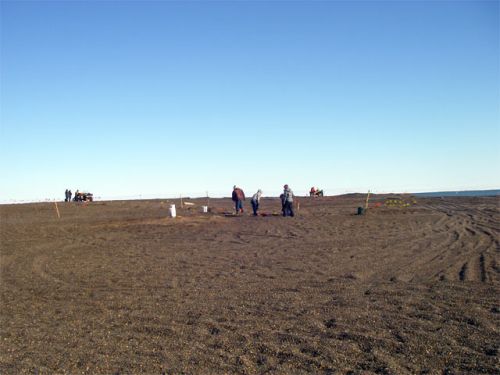 I have worked in a lot of places but this job site is unique. In the distance, you can see the bear guards who keep us from meeting any of the local polar bears. The archaeologists are working on a site that is probably a midden, also known as a trash pile.
I have worked in a lot of places but this job site is unique. In the distance, you can see the bear guards who keep us from meeting any of the local polar bears. The archaeologists are working on a site that is probably a midden, also known as a trash pile.
The tools that are used for the field excavating. Some of these might help in your bedroom!!
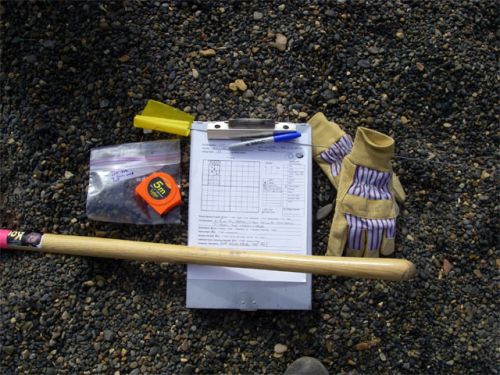 The tools used by an archaeologist vary from no tech (your hands) to low tech (a shovel) to high tech (computer positioning tools). In this shot, you can see my low tech tools: shovel, clipboard, paperwork, trowel, tape measure, ziploc bag, flag to mark the site, sharpie, and gloves.
The tools used by an archaeologist vary from no tech (your hands) to low tech (a shovel) to high tech (computer positioning tools). In this shot, you can see my low tech tools: shovel, clipboard, paperwork, trowel, tape measure, ziploc bag, flag to mark the site, sharpie, and gloves.
In this case, the surface archaeology was already done. We are working on specific sites that are pre-determined. So, a map has already been created. Hopefully, a map has not been established for your bedroom!!
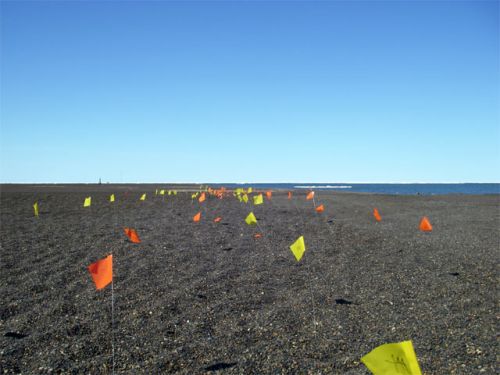 The work being done here often starts with a shovel test pit (STP). The shovel test pit location is set by establishing a line (transect line) and then putting a numbered flag every 2 meters. The digging is then done at each test pit. Once a line a finished, you start working on the next one. They lines are staggered so that every meter is being checked. Think of it this way, you are playing the game, Battleship. You start on the first row and see if your opponent's boat is in the 1st, 3rd, 5th, 7th, ... space. Then you move onto the second row and see if your opponent's ship is in 2nd, 4th, 6th, 8th, .... space. In the third row, you go back to the odd columns. In that way, you are 100% certain that you did not miss a space. In our case, we are 100% certain we did not miss a burial site, house site, and midden.
The work being done here often starts with a shovel test pit (STP). The shovel test pit location is set by establishing a line (transect line) and then putting a numbered flag every 2 meters. The digging is then done at each test pit. Once a line a finished, you start working on the next one. They lines are staggered so that every meter is being checked. Think of it this way, you are playing the game, Battleship. You start on the first row and see if your opponent's boat is in the 1st, 3rd, 5th, 7th, ... space. Then you move onto the second row and see if your opponent's ship is in 2nd, 4th, 6th, 8th, .... space. In the third row, you go back to the odd columns. In that way, you are 100% certain that you did not miss a space. In our case, we are 100% certain we did not miss a burial site, house site, and midden.
Here’s a picture of me after my first hole. Very proud of my accomplishment!!
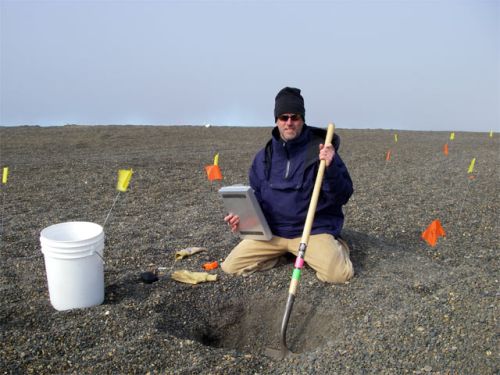 After an overview of what we were to do, I got started on my first hole. It was over quickly, and did not take as long as it did for Stanley in the book, Holes. The second one did go faster, as did the third, fourth, …. At some point, I will become an official "digger".
After an overview of what we were to do, I got started on my first hole. It was over quickly, and did not take as long as it did for Stanley in the book, Holes. The second one did go faster, as did the third, fourth, …. At some point, I will become an official "digger".
Here’s an example of a critical site that the archaeologists here have been working on for the last few weeks. The site contains valuable information about the native inhabitants, the environment, and how the two go together. We are here to excavate these sites, examine the findings, and record our findings. Tomorrow we go into the lab to get an overview of lab work. Thanks for checking in. Stay out of the cold water and clean up your personal sites before someone else does!!
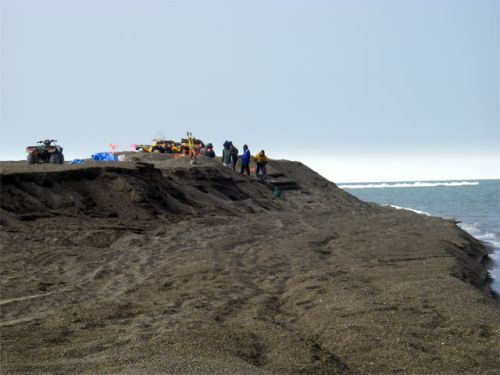 The reason why we are working up here, and working quickly is because the point we are on is eroding, very quickly. This picture shows you just how close the site is to the water. According to Claire, one or two good storms and this site will be gone, washed out in the ocean. Once that happens, the information available in this specific location will also be gone.
The reason why we are working up here, and working quickly is because the point we are on is eroding, very quickly. This picture shows you just how close the site is to the water. According to Claire, one or two good storms and this site will be gone, washed out in the ocean. Once that happens, the information available in this specific location will also be gone.
